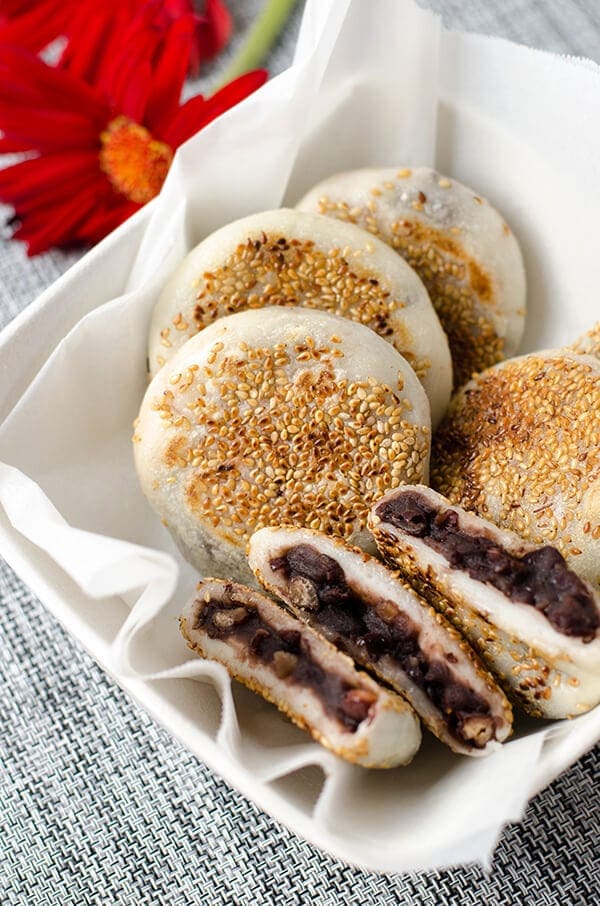
The sticky rice cake with red bean paste is one of my favorite desserts in local Chinese restaurants. Actually, it is not a very standard Chinese dessert and not many restaurants serve it. But since both red bean paste and sticky rice are commonly used in Chinese desserts and pastries, to combine them into one treat makes perfect sense.
I tried my best to recreate this delicious pastry, but I chose to grill the cake in a skillet instead of deep frying. The original version of the cake isn’t coated with sesame seeds and has a golden surface. However, I really don’t like to fry things at home as I always prefer cooking with less oil. So, I invented this method to coat the cake with sesame seeds so the dough won’t stick to the bottom of the skillet, even with little oil in the pan. Plus, it gives the cake a great nutty flavor.
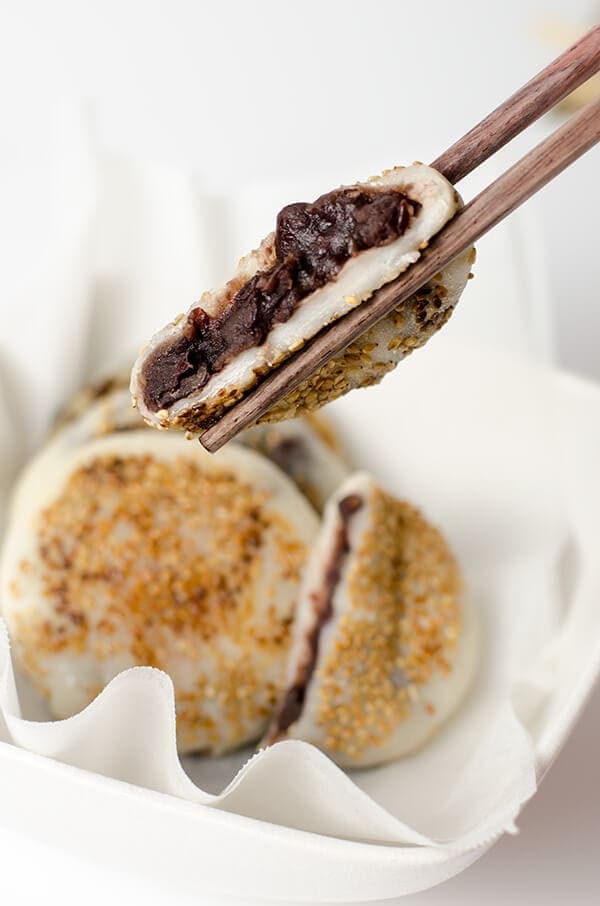
A few more words about Chinese desserts
Compared to the cakes, cookies, and desserts from Europe or the US, Chinese desserts are not nearly as sweet. Instead of butter and flour, they often use lard and glutinous rice flour. Instead of butter cream frosting, they use red bean paste, date paste, or sesame paste to add sweetness. Instead of baking, they invariably require steaming or frying.
If you are not familiar with Chinese desserts, you might find all these elements very strange. However, if you’ve ever tried dessert from Japan or Southeast Asian countries, you might find some similarities among them. If you keep an open mind and would like to try out new things, I hope you will give Chinese desserts, such as this rice cake, a chance as well.
Sometimes, I tend to eat this dish as a snack instead of as a dessert. It is not as indulgent as a piece of cheese cake. Instead, it is quite filling and healthy. Unlike with a snickers bar, I won’t feel guilty at all if I gulp down two slices of rice cake after a workout.
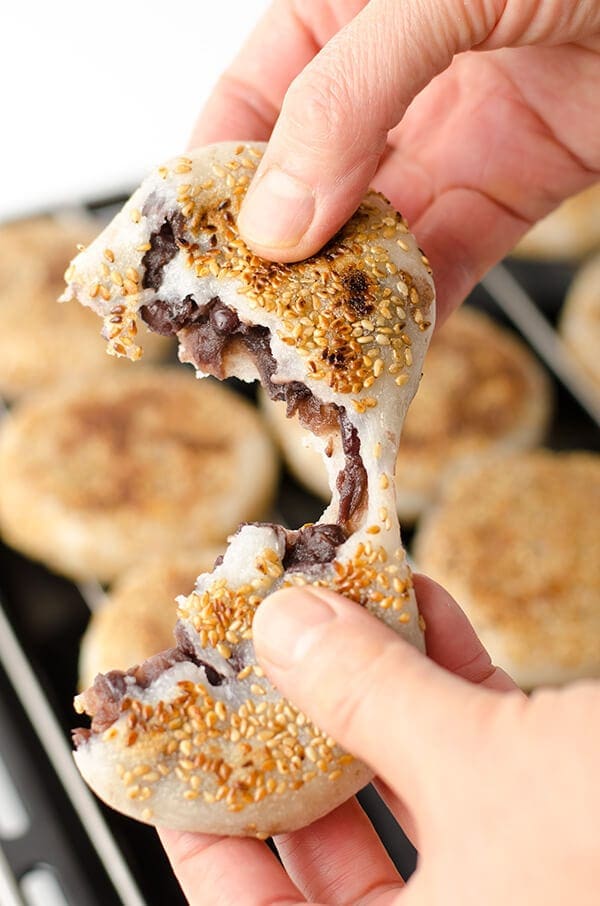
To make sticky rice cake with red bean paste
It is super easy to make this dish and you only need four ingredients. You can find both glutinous rice flour and red bean paste at a Chinese or Asian market. You could also make your own red bean paste at home. It is healthier and even tastier than the kind you’ll find in the supermarket.
When you shop for glutinous rice flour (also called sweet rice flour), make sure you choose the kind that is milled from long grain sweet rice, which is for grilling and baking. The texture is stiff and will form a very crispy surface when heated. The one made from short grain rice is also called mochiko, often used to make cold desserts such as Japanese mochi. Even with the same label, “glutinous rice flour”, it could be made from long grain or short grain rice. Pay attention to this when picking your flour.
Also notice, the so-called glutinous flour (because of the sticky texture) is actually gluten free. However, if you are gluten intolerant, you should look for the variety specifically labelled as gluten free.
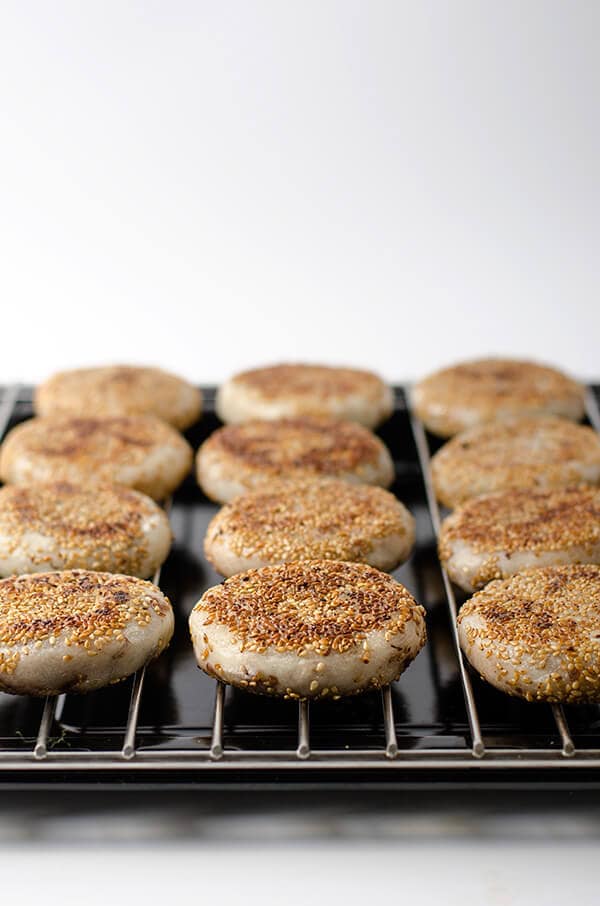
I have created a short video to help you through the cooking process, with an emphasis on how to wrap the red bean paste.
Want more rice cake recipes? Check out my savory Chinese BBQ Sticky Rice Cake and learn how to use kale to create a beautiful green colored rice cake!
Chinese Cooking Made Easy
Are you new to this website? This free email series is a great place to start. I’ll walk you through a few of my most popular recipes and show you how and why they work. You’ll quickly start to cook better Chinese food in your own kitchen.
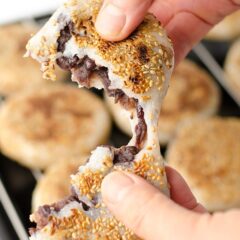
Sticky Rice Cake with Red Bean Paste
Ingredients
- 250 grams (9 ounces) glutinous rice flour and extra flour to dust working surface
- 1 1/2 cups red bean paste
- 1 tablespoon vegetable oil
- 1/2 cup white roasted sesame seeds
Instructions
- Add sweet rice flour into a large bowl. Measure out 1 cup of water (You will use slightly less than a cup). Slowly add water into the flour in 4 to 5 pours, and stir with a fork until the water is fully incorporated with the flour. There should be no dry flour left, and the flour should start to have the texture of dough - soft but not runny. If the dough gets too soft and becomes difficult to shape, add more rice flour, a tablespoon at a time. Use your hand to press and knead the dough a few times, until the texture becomes consistent (* see footnote). The dough should be soft and easy to shape. When you lift the dough from the bowl, it should slightly stick to the bottom of the bowl.
- Dust a working surface with rice flour and transfer the dough onto it. Divide the dough in half. Roll the dough with both hands to shape it into a long, even rod. Divide the dough equally into 6 pieces. Shape each piece into a round ball and set aside.
- To make the cake, place one rice dough ball in your palm and use the other hand to gently press it into a round, flat piece (it’s very easy to shape, so you won’t need a rolling pin), about 6 centimeters (2.5 inches) in diameter, 6 millimeters (1/4 inch) in thickness.
- Scoop about 2 tablespoons of red bean paste and shape the paste into a ball. Place the ball of bean paste in the center of the round dough. Pinch the edges of the dough together to completely enclose the bean paste. When the cake is shaped like a ball, gently use your palm to press it, until it is shaped like a pancake, about 6 centimeters (2.5 inches) in diameter and 1.2 centimeters (1/2 inches) in thickness. Spread 1 tablespoon of sesame seeds onto the working surface, place the cake on top of them, and gently press. Shake off the extra sesame seeds, flip the cake, and press the other side onto the seeds. Craft the rest of the cakes in the same manner.
- Heat 1 teaspoon of vegetable oil a non-stick skillet over medium heat. When the oil is hot, turn to medium low heat and place 4 cakes into the skillet. Cook until the bottom of the cake turns golden brown, after 2 to 3 minutes. Flip and cook the other side. Transfer the cakes to a large plate to cool. Cook the rest of the cakes in the same manner.
- Serve the rice cakes warm.
Notes
- Unlike dough made from wheat flour, rice flour dough is much easier to knead and doesn’t need time to rest. The dough does not contain gluten, so it won’t hold very well when stretched. The way to handle this type of dough is different, but you will find it very easy to get used to.
Nutrition

Did you make this recipe?
I’d love to hear how it turned out for you! Please take a moment to leave a 5-star rating ⭐️ and share your thoughts in the comments further down the page. It really helps others discover the recipe too.
The nutrition facts are calculated based on 1 of the 12 cakes generated from this recipe.
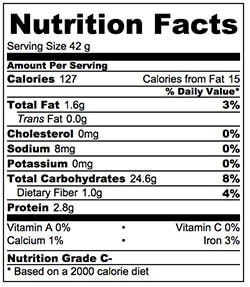

Shanna Hattaway
daifuku, my favorite! I can’t leave my local produce stand without buying one. The addiction is real.
Linda @ Roti n Rice
These look so good. Perfect for tea time!
Nikky
I absolutely love these … so excited to try these out at home .
Being nigerian we also eat red bean paste but with coconut milk sweet and with chillies .
Maggie
I’m so glad to hear you like the recipe Nikky!
Wow, I didn’t know you cooking with red bean paste too. Adding coconut milk and chillies into it sounds so delicious! Is that a cake filling too? I really want to try it out 🙂
Nikky
We dont do it within a cake but i tried it and its absolutely amazing .
With your original recipe after frying it
Maggie
That sounds amazing! Do you have a recipe? I’d love to try it out 🙂
Marion
I want to bring these to a dinner party. Can I/should I cook them at home and bring them precooked? If so, should I simply serve them at room temperature, or reheat them in my host’s kitchen? To reheat, would I microwave them or put them in the oven (on a low temperature)? If I shouldn’t cook them ahead, how would I transport uncooked rice cakes? Would they be okay in layers on wax paper, for example?
Thanks so much for your help!
Marion
Maggie
Hi Marion, you can cook them at home and reheat the cakes at the party. To serve the cakes warm, the best way will be cooking them on stove top. You can place them in a non-stick skillet and cook over medium heat. When the skillet turns hot, flip the cakes, add a few tablespoons water and cover immediately. Turn to medium low heat and cook until the cakes are heated through. The cake will be crispy outside and gooey in texture. Alternatively, you can use microwave. The cakes will be gooey, but the surface won’t be crispy. I haven’t tried to reheat them in the oven. I think it’s possible, but you need to wrap the baking tray with aluminum foil and add a few drops water onto the tray, to prevent the cakes from drying out.
I hope this is helpful, and your dish will be a hit at the party! 🙂
Marion
So, I made these yesterday at home, brought them to my sister-in-law’s, rewarmed them as you suggested — and they were pronounced a success, including by my (knowledgeable) Japanese-American relatives! Yay!! (And I like them cold, too.) My only complaint is that I found it impossible to completely enclose the red bean paste filling. Before I started that step, they looked just like your picture of the ball of red bean paste on top of the cake — but in your picture it looks impossible to get that little bit of cake around that big ball of red bean paste, and that proved to be the case in real life. I started putting less filling in each one, but I still never managed one that didn’t show some red filling on the outside. Fortunately, unlike some pastries I’ve made, it didn’t really matter: The filling didn’t ooze out, and the sesame seeds mostly covered up the messy look. Also, I found it easier when I wet my hands and added a little more water to the dough, so maybe I should’ve had
more water in the dough to begin with; maybe that would’ve helped.
Anyway, thanks for the recipe and for the help!! It was fun making, serving, and eating these — and I doubled the recipe, so I still have some!
Maggie
Hi Marion, I’m SO glad to hear the cakes received good review! You just made my day 🙂
Yeah, the wrapping part can be tricky, because the dough won’t hold together like wheat flour (no gluten inside). Yes, adding a bit more water to make a tenderer dough will be helpful. The dough is quite forgiving, and you can adjust its texture even after kneading. The dough will be easy to wrap, when it’s tender and able to spread with hand, without breaking it apart. It will become sticky if it turns too soft. On the other hand, just as you said, it won’t cause a problem even the filling is not completely enclosed.
I’m so glad to hear you enjoy the cooking too! And thanks for leaving a thorough feedback to let me know 🙂 You’re so kind.
Enjoy the rest of the weekend Marion!
Shiho
Maggie, This is fantastic. My favourite!! Very similar to a sweets called OYak in Japanese. Thank you for sharing the great recipe.
Sokehah Cheah
Made this recently, yummy. Thanks for sharing.
http://www.nofrillsrecipes.com/2015/10/sticky-rice-cake-with-red-bean-paste.html#.VhtV1_mqqko
Freya
Can i steam these instead?
Maggie
Hi Freya, I never tried to steam these cakes. I’m afraid they won’t hold the shape so well. The surface will turn crispy and adds a nice texture. If you steam the whole thing, it will be quite gooey and sticky. I won’t recommend to steam them.
Bam’s Kitchen
I can’t believe it! I have read this recipe a million times before, but did not comment!! This recipe rocks and have made it a few times before and your directions are spot on. Well we need to make that at least 9K repins so on my way to share, pin and send smoke signals… Wishing you and awesome weekend!
Kathleen | HapaNom
Oh Maggie! This looks fantastic! I absolutely love desserts like this (American desserts tend to be too sweet for my liking). While I haven’t had this exact dessert before, I imagine it would taste much like toasted mochi – would that be about right?
Tweety
Hi Maggie,
I have been looking for this kind of great recipe! Wow. your recipe is like a GOD-sent!
I love this pastry and it’s hard to find in everywhere, it seems!
Thank you so much.
I will continue to follow your recipes and support you to come out with more and more inspiring recipes.
Regards,
Happy Beginner to baking
Maggie
Thanks for the comment and all the kind words! So glad to hear you like the recipe, and the type of pastry. Dessert that made from sticky rice is very common here, but it’s probably not a standard dessert item outside of Asia. It’s great to hear someone out there cares about it 🙂
Also, please feel free to drop me a message if there’s a recipe you can’t find.
Have a wonderful day and happy cooking!
Saskia
The glutinous rice flour I can get gives me no indication of what type of rice was used! If I use the wrong sort will it be a complete disaster or will it just have a different texture to what it is supposed to?
Saskia
The rice I have in my cupboard is the same brand as on this website: http://www.templeofthai.com/food/flour_sugar/sticky-1220111107.php
Maggie
Hi Saskia, I just checked the rice flour on the website you told me, it’s the same brand as the one I used, so it should be the right one. Even if you used the wrong type, it won’t cause a huge problem (the finished cake will has a less crispy surface, but still tasty). Hope is helpful and happy cooking!
Linus
Hey Maggie,
Great blog! I only recently discovered it and the recipes are really excellent.
This take on the sticky rice cake really reminds me of the Korean street food Hotteok, the construction and cooking method are very similar, although the dough and filling are a bit different. I’ll be sure to try it soon!
Maggie
Hi Linus, thanks so much for the kind words and so glad to hear you like my recipes!
I just googled Hotteok, and yep, it really looks like the Chinese rice cake! I saw sometimes they use a filling with brown sugar and some nuts, and it sounds so delicious! Thanks for sharing this and I’d like to try out the Korean version filling with the rice cake too.
Happy cooking and let me know how it goes 🙂
Susan
I’m excited to see this recipe. It takes me back about 40 years to when I took a Chinese cooking class with some ladies I worked with. I really enjoyed this dessert and am delighted that I can now make it if want to (but I’m not sure my husband would like it). Thank you for posting this recipe.
Maggie
Hi Susan, thanks for leaving a comment and I’m glad to hear you like this dessert! It’s interesting to learn that Chinese cooking class choose this one to teach, because I thought it’s not so well known outside of China. Hope you have a nice weekend and happy cooking! 🙂
Susan
Actually, Maggie, I think that one of my co-workers, a Japanese lady brought them to class. I don’t remember them being fried, but I do remember that they tasted really good.
Maggie
I know the Japanese one and you’re right, it’s not fried. The Japanese rice cake uses the other type of glutinous flour (the one that is milled from short grain sweet rice), and the dough is steamed before wrapping with the red bean fillings. The recipe here uses the glutinous flour that is milled from long grain sweet rice. The surface of dough will turn crispy after heated, while the texture inside is still gooey. (Sorry this might sound confusing)
If by any chance you want to make the Japanese rice cake, you can get the recipe here => http://www.justonecookbook.com/recipes/daifuku/
I guess it’s close to the one you mentioned. I cooked a lot of Japanese food from Nami’s site and she has amazing Japanese recipes. Hope this is helpful 🙂
Michelle @ The Complete Savorist
I have not had these in years…and by years, I mean at least two decades. They actually look easy enough for me to make at home. Pinning!!!
Maggie
Yes, the rice flour is even easier to deal with than wheat flour. The dish was intimidating to me at first, but then I was so surprised how easy it is when I made it! Thanks for sharing 🙂
Bonnie Eng
You are an artist Maggie! The video and photos are outstanding–so informative, and so clear. Bravo, the cakes look scrumptious and you are awesome! 🙂
Maggie
Thanks very much Bonnie! I like this one too and tried very hard to make the photos as good as it tastes 😉
Nami | Just One Cookbook
I had way too much fun watching your video for this sticky rice cakes and I have to say I’d need like 5 of them at one sitting… Looks so good. I love red bean sweets. Japanese mochi we don’t really fry it, so it’s very fun seeing how you guys make this. Oh and I love the sticky mochi shot! Brilliant!!!!
Maggie
Isn’t it interesting that Chinese and Japanese dishes share so many similar ingredients, but they also have slight differences? I love eating mochi while I was living in Japan, but never thought it uses different type of rice flour (short grain vs. long grain). Took me some time to figure that out!
Watching your Daifuku video was great fun for me too! I’d never imagine you need to steam the dough first!
Lokness @ The Missing Lokness
I hate frying at home too. Grease flying everywhere in the kitchen. What a smart idea to coat the rice cake with sesame seeds. Add more flavors and great crispy texture. I love red bean and rice cake. This is totally a must try. Your pictures are gorgeous as always, Maggie!
Maggie
Thanks Lokness! I use whatever way I can to avoiding frying!
Annie
Love these! My mom sometimes makes something like this, but it’s a full cake with red bean paste in various places (because she mixes it slightly). It has the exact same texture…..I was wondering if you could make that, along with some history? I need some background information on it for school…..you don’t need to, please don’t feel like I’m commenting just to get information, these are truly awesome!
Thalia @ butter and brioche
Wow these red bean rice cakes definitely take me back to my childhood! My Chinese grandfather used to always make something similar for me to devour. Thanks for reminding me how awesome and delicious they are.. definitely need to recreate the recipe asap!
Maggie
Hi Thalia, I didn’t know you have a Chinese grandfather! Really glad to hear that there is quite some people like the taste of red bean paste, I was afraid the flavor is too unfamiliar to non-Chinese readers. Besides the sticky rice version, I think the paste goes great in a baked crispy pastry. Do you think so?
lily
So excited 2 find what I’ve been searching for since mom past away. But she made a “sieu bang ” which had no filling & was sweetened which we wrapped a pc of crispy roast pork in it. It was baked & hot water used to mix w/the glut flour. So I have not yet accomplished my search. Any idea?
Alice @ Hip Foodie Mom
oh my gawd, I love these!!! Koreans have a similar dessert as well using the red bean paste! Love this and pinned!
Maggie
Interesting, I didn’t know there is a Korean version of red bean paste dessert too! I’d like to try it if I ever come across them! Thanks for sharing 🙂
Min
Wow! Thank you so so much for sharing, Maggie! This is seriously one of my favs and I never dared to make this at home bc like you, I don’t like to fry anything in my kitchen! Brilliant! Pinned.
Maggie
Hi Min, thanks for sharing! Yeah, I totally understand your feeling towards fried food, and I didn’t expect this dish is so easy to cook at home. Glad you like it 🙂